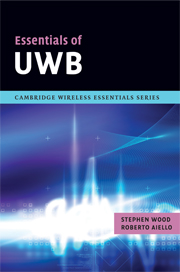Book contents
- Frontmatter
- Contents
- 1 Introducing ultra-wideband (UWB)
- 2 Matching UWB to HDR applications
- 3 Physical-layer (PHY) characteristics
- 4 Media-access control (MAC) layer
- 5 Implementation information
- 6 Upper-layer protocols
- 7 Ultra-wideband standardization
- 8 Special-interest groups
- 9 Ultra-wideband business issues
- 10 Regulating ultra-wideband
- 11 Tragedy of the commons
- Appendix: Reference documents
- Author biographies
- Index
- References
10 - Regulating ultra-wideband
Published online by Cambridge University Press: 22 August 2009
- Frontmatter
- Contents
- 1 Introducing ultra-wideband (UWB)
- 2 Matching UWB to HDR applications
- 3 Physical-layer (PHY) characteristics
- 4 Media-access control (MAC) layer
- 5 Implementation information
- 6 Upper-layer protocols
- 7 Ultra-wideband standardization
- 8 Special-interest groups
- 9 Ultra-wideband business issues
- 10 Regulating ultra-wideband
- 11 Tragedy of the commons
- Appendix: Reference documents
- Author biographies
- Index
- References
Summary
After more than 80 years of using a regulatory environment that is characterized principally by frequency and, to a lesser extent, spatial division to avoid interference, UWB introduces the significantly different concepts of spectrum underlay and ‘detect and avoid’ (DAA). Both of these concepts are somewhat experimental and clearly evolving over time. It is reasonable to expect that regulations governing UWB around the world may change somewhat over the next few years as we learn more about what does and does not work well in the UWB experiment.
Additionally, regulators are looking to see which applications the industry will choose to deploy UWB for. Some applications are potentially problematic from an interference perspective and others are relatively inert. The choices that UWB manufacturers and implementers make about applications will have an effect on the regulatory environment. If the industry elects to deploy a greater number of problematic applications than was estimated during the regulatory hearings, this will be of material interest to regulators and may cause them to introduce regulatory limits to discourage that deployment. The conscientiousness that the UWB industry shows in its efforts to avoid interference to incumbents will also influence how generous regulators are toward UWB interests in later rounds. As an example, if the UWB industry pushes uncoded and minimally coded video heavily in the crowded lower frequencies, it may be necessary for the regulators to issue more stringent rules to protect the incumbent services.
- Type
- Chapter
- Information
- Essentials of UWB , pp. 148 - 186Publisher: Cambridge University PressPrint publication year: 2008



